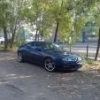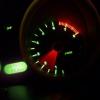Welcome to Squadra916
Register now to gain access to all of our features. Once registered and logged in, you will be able to contribute to this site by submitting your own content or replying to existing content. You'll be able to customize your profile, receive reputation points as a reward for submitting content, while also communicating with other members via your own private inbox, plus much more! This message will be removed once you have signed in.
Leaderboard
Popular Content
Showing most liked content on 17/02/13 in all areas
-
1 point
-
1 pointPaso, you are probably right. Alfa Romeos are sporty, but also elegant cars. Better suited engine for the character of that car are bigger NA (naturally aspirated) engines 3.0 and 3.2 (i think that maybe Alfa Romeo had to offer something like 2.8 supercharger for top of the range , something like AMG in alfa way ). And with FWD they are probably enough. But with turbocharged engine in it I want to unite that gorgeous look with power to match. So what to be tonight. Lets answer to Thanos question. GTV V6 tb stock fuel system comprises of the following major components (specs are from the manual): - Bosch high impedance 189cc/min at 3 bar (18 lbs/hr) fuel injectors (15.9Ω ±0.35Ω); - linear fuel pressure regulator with 3 bar base pressure and max control pressure of ~4 bar; - fuel pump specs: flow rate: ≥120l/h; pressure: 4 bar; nominal voltage 12V; Stock fuel injectors are for stock turbo setup. In my opinion even a car with upgraded chips, tuned at around 230 hp will have significantly lean A/F ratio on boost and higher rpms. Their flow capacity can be increased by using high pressure fuel regulator, but this will load fuel pump (and decrease it's flow capacity) and it also should be changed for more powerful one (capacity and pressure). And after all the increase shouldn't be much more (with 4 bar 1:1 regulator their max flow will be 218.2 cc/min). So for bigger than stock turbo setup the fuel injectors should be changed. The upgraded injectors should be high impedance (because the injector drive is for saturated type of control -> high impedance injectors) Bosch type with EV1 connector. The stock spray pattern is 30o cone , that is for 2 valve per cylinders (multi valve cylinders use wide pattern). I think that all Bosch 0 280 150 xxx injectors use that pattern and have same shape (GTV 2.0 V6 tb - 0 280 150 702), but not sure. So with bigger turbocharger I will need bigger fuel injectors and I bought these. Bosch "red top" 315cc/min at 3 bar (30 lbs/hr) with part number 0 280 150 945 (I have also seen other values for capacity and I do not want to argue about that ). Application: Ford Motorsport . I have bought these from one guy with BMW e30 323i turbo, who wanted to get bigger one for his car. He bought that new one year before I get them from him and he told me that they have been used for around 7000 km . There is one simple rule of thumb for evaluating max power that given injectors are good for: ("max flow at cc/min" / 5) x "number of injectors". So lets do some calculations . So from above rough rule: (315/5)*6=378 hp. For more precise calculations can be used correct equations and online calculators. And now for the fuel pump. So with stock fuel pressure regulator (at 3 bar) -> (315x6x60)/1000≈113.4l/h ( ("cc/min for one injector" x "number of injectors" x "one hour in minutes")/ 103 for convert from cubic centimeter to liter). But when on boost the pressure in the fuel rail will be higher than base pressure with addition - boost pressure. But when working on higher pressure the pump work harder and their flow drops.Its flow also depend on the voltage which actually reach it. The above mentioned flow of the fuel pump is probably given at standard pressure of 3 bar and at 4 bar (1 bar boost) should be less. So injectors will be on or over the limit of stock fuel pump at max duty.. There is one rule that capacity of fuel pump should be at least 20% more than sum of all injector. And another recommendation is that duty cycle of fuel injectors shouldn't exceed 80%. In my opinion and for safety reason the pump is good to be upgraded with something more powerful and new, for example Walbro 255l/h at 3 bar. Bigger injectors that can be used are from Punto GT/Alfa 3.0 v6 (part number: 0 280 150 701), they flow around 240cc/min at 3 bar. And enough for this post. Thanos have to be pleased .
-
1 pointThanks! I don't have good pictures of the car like most members of the forum , so it's a little embarrassing to show not beautiful pictures in this forum. When I go to Croatia at one of your alfa events , you can make some pictures of the car with your cars,that should be good for this forum. But my car have to be in the back . Аnd let's move on. More powerful turbocharger and intercooler are present. So here comes the control of unwanted boost and more specific the dump valve. GTV V6 tb like all serial turbo cars have recirculated dump valve. It's made by Bosch and uses diaphragm. The principle is unwanted boost pressure to be returned back to intake, because it is already measured by the AFM/MAF. But over the years that diaphragm recirculating dump valve loose it characteristics and sometimes the diaphragm breaks. For cars with AFM/MAF (like GTV V6 tb) is highly recommended to be used such type of dump valve, so the optimal variant is serial one to be changed with aftermaket recirculated dump valve which don't have diaphragm and will be more reliable over the years (and maybe quicker). But the medal have other side and it is the noise from dumping to atmosphere valve, that blow-off sound . For cars with AFM/MAF the only variant is dual piston BOV(Blow-Off valve) with which the car will not turns off at idle. If you install single piston BOV on car with AFM/MAF it will turns off every time it start to work at idle. But for car with MAP - Mass Air Pressure sensor (speed density concept) any time of BOV can be used. I will return on the variant for dual piston BOV on car with AFM/MAF. The "advantage" is the sound of BOV when you lift off the throttle on boost, but disadvantages are more rich mixture at lift of off the throttle and respectively more fuel consumption at this moment. The rich mixture can foul your spark plugs over the time. The combustion at this moments will not be optimal and can lead to unburned fuel in the exhaust. And unburned fuel in the exhaust will affect oxygen sensor reading and from that will lead changes by ECU and ... . So if you can suppress the racer in you then you will made the right decision and use a recirculated BOV. But if you plan to change the ECU with aftermarket and then use "speed density" concept with MAP you can use whatever BOV you like because ECU will calculate the mixture from pressure at intake manifold and not from measured air by AFM/MAF. With more free flow intake the sound from dump valve (recirculated or to atmosphere) will be increased. I like BOV sound very much , so you can guess what type I chose . So I bought Forge Motorsport dual piston BOV (i like the parts from that brand ). Made from billet aluminium. Very nice. I don't know with what spring it come, but If it don't perform well I can buy another springs and to tune it for me. So this will be end of this post .
-
1 pointIn tonight "episode" I will continue on the path of air. After filter the air is "pumped" to engine by compressor side of turbocharger. But boosted air have increased it's temperature which lead to less oxygen and respectively less power. So here comes the intercooler. GTV 2.0 V6 tb have side mount intercooler with "in" and "out" situated on same side. The advantage of this is shorter piping for air. For stock car it is enough and probably for chipped car with stock turbo setup (I think that chipped car driven hard at hot day will suffer from hot air). But for car with upgraded turbo setup should be considered more powerful and efficient intercooler. So bigger and front mounted intercooler (FMIC) have to replace stock one. I'm not fan of the chinese performance parts, so I don't want to install some universal chinese intercooler (but most do that and are happy). I start liked one model Forge motorsport intercooler, it is at fairly good price, I think that should be enough for my setup and because of it's small dimensions will be more easy to be installed at back of the bumper. But I also look around for second hand good brand intercoolers and come across one bigger and made a decision to buy it. This is Forge motorsport intercooler. I don't know the exact model and never mind (the guy from which I bought it said that is from S3 or Leon Cupra, I've already forgot). The dimension of the core are 625x175x80 mm (Length x Height x Width). The plan was to be made custom end tanks (by the men who should made full exhaust system, nothing new for him ). First because with that centrally located in height "in" and "out" will blocked the path of the air pipes by two convex bars at the front of the car. It's dificult to me to explain so like they say - one picture is more that thousand words . GTV_front_bars.bmp (interesting thing is that I found this picture when searching in google and it is from this forum , I will write something in that topic later) Other thing that I want to change is diameter of "in" and "out". I think that they are 51mm, but I'm not sure and can't measure it soon. I think for 2.25"(57mm), 2.5"(63mm) or 2.75"(70mm) diameter of input and output (probably 2.5"). Air piping have to be made with aluminium pipes and some silicone joints for damping of vibrations. And that will be end for tonight.
-
1 pointWheel number 1 is cleaned and finnished for the new season! Bought Pirelli rosso 235-35-19 instead of the 225 i have now for the back wheels, hope they will fit nice!
-
1 pointLet's write some things in my topic. First of all I want to apologize for the quality of the pictures! They were made in one go with telephone! Some time after changes mentioned in the first post I began to think about buying of other performance car with bigger tuning potential, with lots of performance parts on the market at "good prices" (as far as this can be said for performance improvements ) and with many developed projects and info on the web. The cars on which I focus my attention was Subaru Impreza WRX STI "bugeye"('01-'03) or "blobeye"('03-'05), especially second one. I don't wanted to sell my GTV and thought to keep it and the serious stuffs to be made on the creature of Subaru Tecnica International . After some time of researching of above mentioned cars , primarily on performance stuffs, I again change my mind . That plan probably would too difficult. At that time I was wondering what to do and one day I saw auction for Garrett GT2860RS ("disco potato") at Ebay.co.uk. Brand new, unused in the box. After little reflection I told to one friend of mine to bid for it with exact limit (I haven't got account) and whatever gets. And after the end of auction I have win this package The exact turbocharger is: Garrett GT2860RS, 0.86A/R turbine housing, T25 exhaust flange, oil and water cooler with internal wastegate. The original "disco potato" . The smaller 0.64 A/R was offered later (such uses Bruno Galrito on his GTV ). Turbine housing A/R (Area/Ration) plays an important role for boost response and turbo operating range. Smaller A/R is for quicker boost rise but at the expense of high backpressure at high engine speed and more "tough breathing" of the engine. Larger A/R have delay in spool in comparison with smaller A/R, but less backpressure at high engine speed and more power respectively. This is why aftermarket turbochargers are offered with choices of exhaust housing A/R. Compressor Housing A/R don't have much influence on turbocharger performance. Original GTV turbocharger also uses T25 exhaust flange, but downpipe flange is different. The space in the engine bay is limited and this is a little bigger turbocharger. In short this is not plug and play turbo for GTV 2.0 V6 tb. Custom made exhaust manifolds and downpipe should be made to fit. My plan was for full custom made exhaust system from stainless steel - manifolds, downpipe, flexible pipe, 2.75" (70mm) from turbo backward with two mufflers in parallel with two end tips each . And I know a guy very good at these stuffs in my hometown . Because GTVs engine bay get very hot (even in standard form and with tubular manifold even hotter) I plan to use exhaust heat wrap for exhaust manifold (and maybe turbo shield for turbine housing). I prefer titanium one, because it can withstand very high temperatures . Тhus the main source of heat in the engine bay (exhaust manifold) will be limited and the heat will stay where should be - inside of exhaust. The gases remain their high temperature and therefore move faster, which is good thing . Exhaust heat wrap have good effect with tubular manifold, but it is not recommend for stock, log type manifolds. So enough for single post. Soon to be continued ...
Welcome to Squadra916
Squadra916 is the largest international community for owners and fans of Alfa Romeo GTV and Spider 916 cars.





